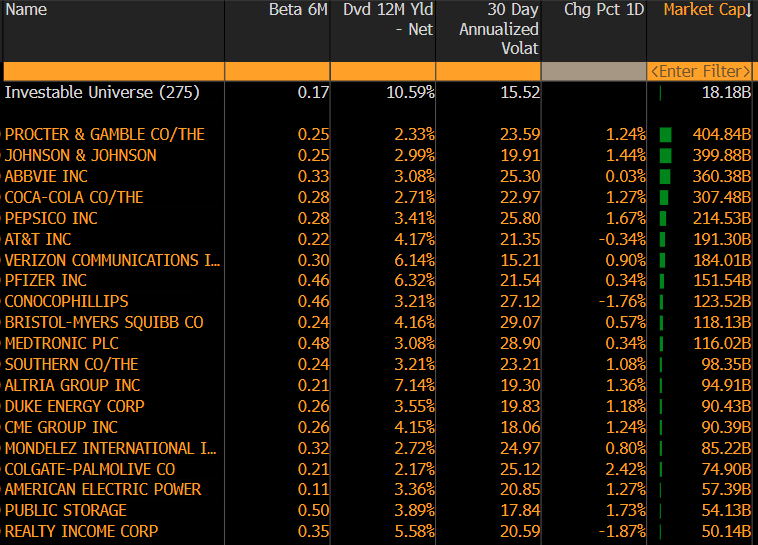Quarterly Outlook
Macro outlook: Trump 2.0: Can the US have its cake and eat it, too?
John J. Hardy
Global Head of Macro Strategy
Chief Investment Strategist
We talked about the risks of U.S. exceptionalism fading and the diluting Magnificent 7 leadership in previous articles. This is leading to a risk-off sentiment in global markets, and a rush to safe havens.
When markets get choppy, some investors reach for cash. Others look for the smoothest ride possible, and that’s where low-volatility stocks come in. These are companies with steady earnings, strong balance sheets, and a history of riding out economic turbulence better than the broader market.
That’s where low-volatility, high-dividend stocks come into play. These stocks tend to have low beta values, meaning they move less dramatically than the overall market, while also offering attractive dividend yields. This combination can provide both capital preservation and steady cash flow, making them an excellent option for defensive investors.
Volatility is often an investor’s worst enemy, especially during market downturns. Low-volatility stocks tend to hold their ground better, reducing overall portfolio risk. They are typically found in sectors such as utilities, consumer staples, and healthcare—industries where demand remains stable regardless of economic cycles.
A stock’s beta measures its sensitivity to market movements. A beta below 1 indicates lower volatility compared to the broader market, meaning these stocks tend to decline less in bear markets while still participating in bull markets, albeit to a lesser extent.
Dividend-paying stocks offer an additional layer of security by providing regular income, even during market downturns. Companies with strong, sustainable dividends often have healthy balance sheets, stable earnings, and a commitment to returning value to shareholders. High-yield stocks can help offset price declines and enhance total return over time.
We ran a defensive equity screener on Bloomberg, based on the following criterion:
Several standout stocks fit this defensive profile. Here are a few notable names grouped by sector:

Source: Bloomberg
For investors seeking a balance of risk management and income, a mix of low-volatility, high-dividend stocks can be a smart addition to a diversified portfolio. These stocks provide protection during market downturns while still generating returns through dividends.
While no investment is without risk, these stocks present a strong case for those looking to minimize volatility without sacrificing yield. By focusing on companies with stable cash flows and sustainable dividends, investors can create a more resilient portfolio in today’s uncertain market environment.
Disclaimer
The Saxo Bank Group entities each provide execution-only service and access to Analysis permitting a person to view and/or use content available on or via the website. This content is not intended to and does not change or expand on the execution-only service. Such access and use are at all times subject to (i) The Terms of Use; (ii) Full Disclaimer; (iii) The Risk Warning; (iv) the Rules of Engagement and (v) Notices applying to Saxo News & Research and/or its content in addition (where relevant) to the terms governing the use of hyperlinks on the website of a member of the Saxo Bank Group by which access to Saxo News & Research is gained. Such content is therefore provided as no more than information. In particular no advice is intended to be provided or to be relied on as provided nor endorsed by any Saxo Bank Group entity; nor is it to be construed as solicitation or an incentive provided to subscribe for or sell or purchase any financial instrument. All trading or investments you make must be pursuant to your own unprompted and informed self-directed decision. As such no Saxo Bank Group entity will have or be liable for any losses that you may sustain as a result of any investment decision made in reliance on information which is available on Saxo News & Research or as a result of the use of the Saxo News & Research. Orders given and trades effected are deemed intended to be given or effected for the account of the customer with the Saxo Bank Group entity operating in the jurisdiction in which the customer resides and/or with whom the customer opened and maintains his/her trading account. Saxo News & Research does not contain (and should not be construed as containing) financial, investment, tax or trading advice or advice of any sort offered, recommended or endorsed by Saxo Bank Group and should not be construed as a record of our trading prices, or as an offer, incentive or solicitation for the subscription, sale or purchase in any financial instrument. To the extent that any content is construed as investment research, you must note and accept that the content was not intended to and has not been prepared in accordance with legal requirements designed to promote the independence of investment research and as such, would be considered as a marketing communication under relevant laws.
Please read our disclaimers:
- Notification on Non-Independent Investment Research (https://www.home.saxo/legal/niird/notification)
- Full disclaimer (https://www.home.saxo/en-gb/legal/disclaimer/saxo-disclaimer)